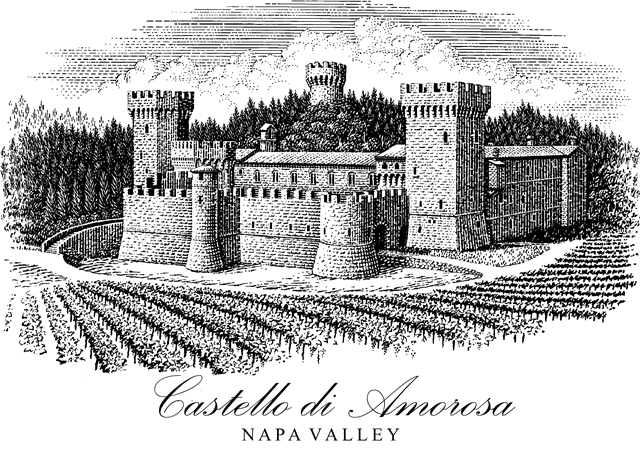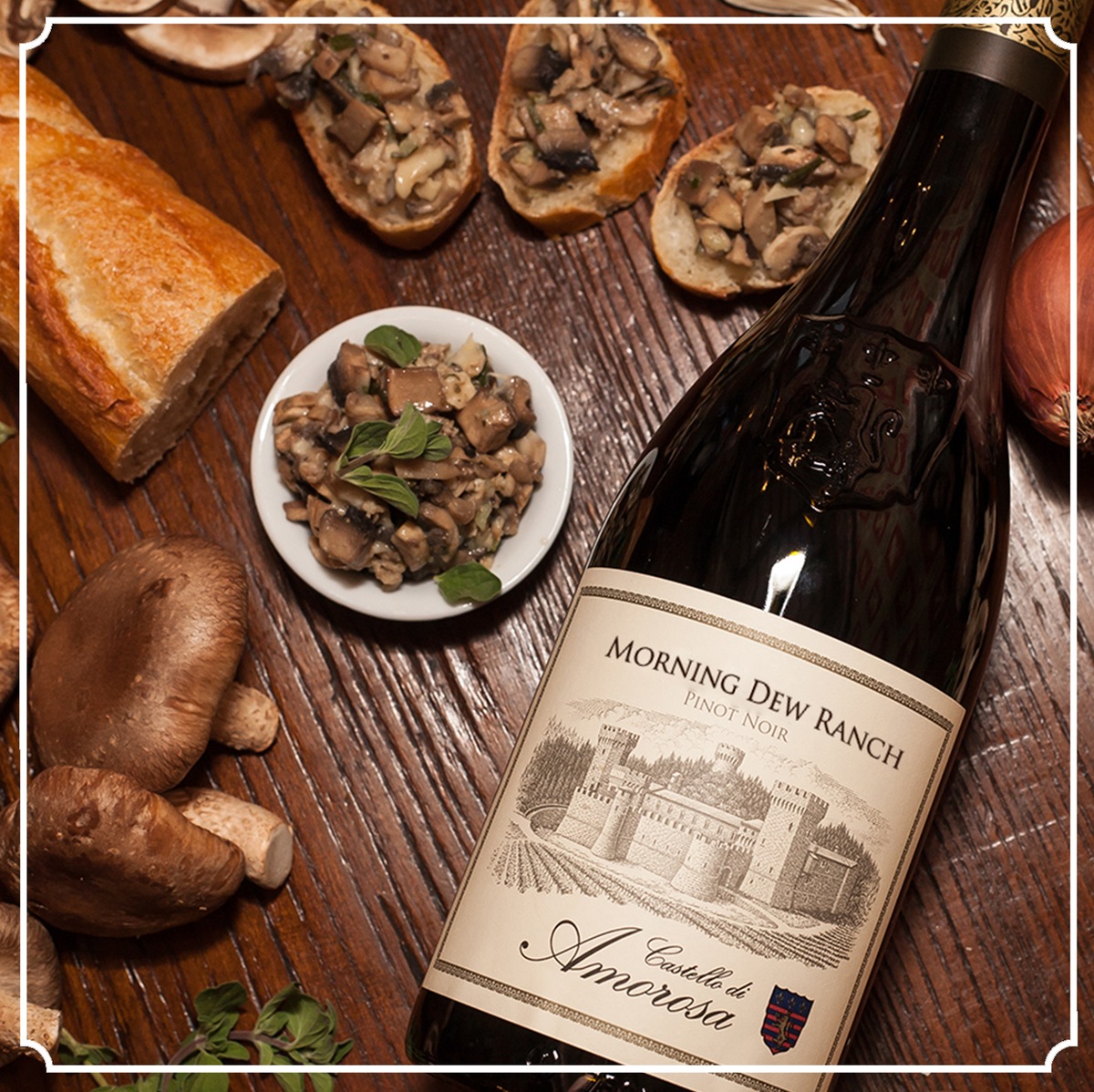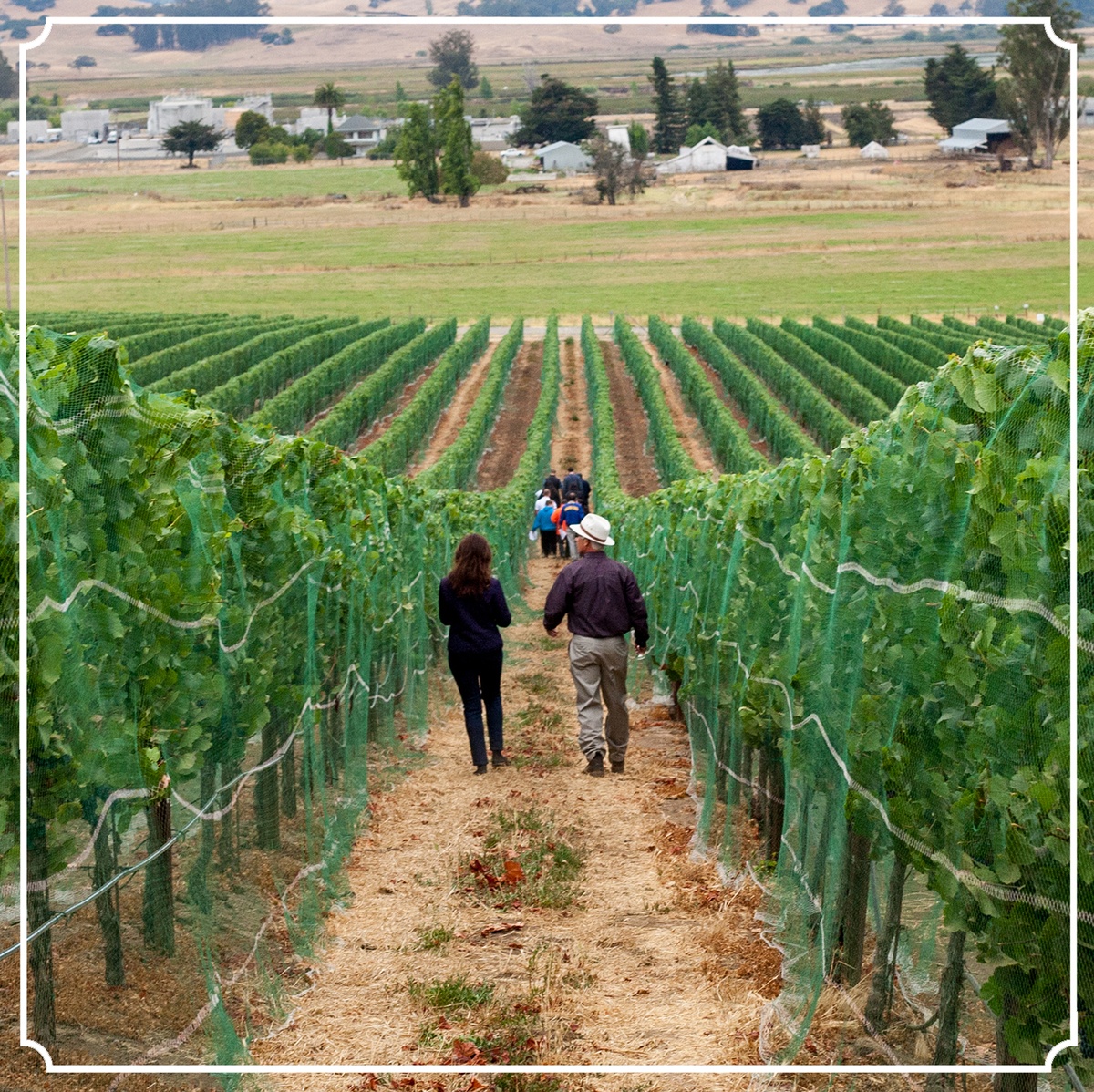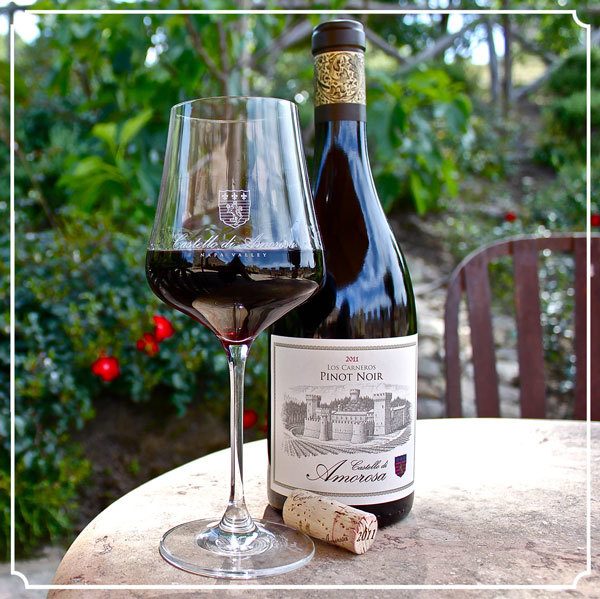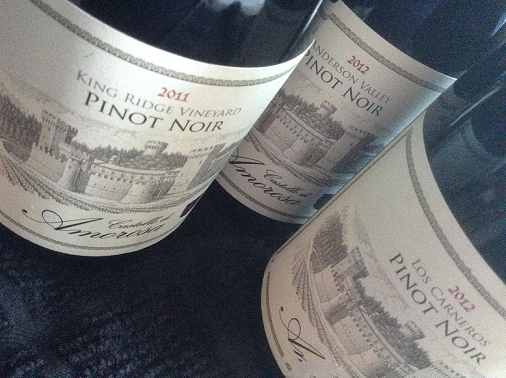Cacio e Pepe

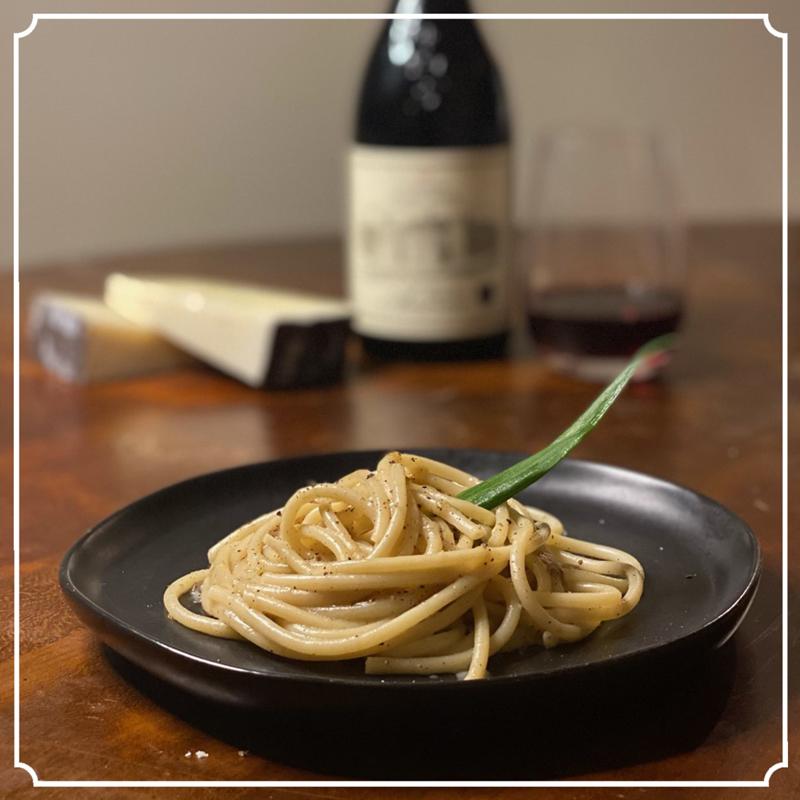
Recipe Date: December 2nd, 2020
Difficulty: Easy
Measurements: Imperial (US)
Cacio e Pepe
From Laura in The Kitchen
The Cacio e pepe pasta, an incredible dish of the ancient Roman Sheppards’ dating back to the 5th century. This remains a simple dish for the everyday people that is now quite famous in Italian cuisine. We are pairing this pasta with our Pinot Noir that gives a complimenting spice when paired together. The recipe below is by Laura Vitale of the Laura in the Kitchen Youtube channel. She began cooking in the kitchen of her Grandmother in Naples, Italy and brought her love of creating “food that feeds the soul” to the United States.
Ingredients
- 8oz of Spaghetti
-
3oz of Finely Shredded Pecorino (see notes below)
-
1-1/2 tsp of Freshly Ground Black Pepper
- Salt
Directions
• Fill a pot with water, add a generous pinch of salt (not too much) and bring to a boil, add the pasta and cook 2 minutes shy of package instructions.
• In a large skillet (I prefer a non-stick heavy duty skillet here) add the ground black pepper, toast for about a minute, meanwhile reserve a couple of cups of starchy cooking water and set aside while you drain your pasta.
• Add 1/2 cup of the starchy water to the bowl of shredded cheese, stir and set aside.
• Add an additional 1/2 cup of the starchy water to the skillet with the pepper, then add the spaghetti (make sure the heat is on low) and start adding your cheese mixture, constantly stirring until Emulsified and adding any additional cooking water if needed. Continue the process until your sauce comes together.
Notes
This dish is one you need to practice, so many things can create a clumpy split mess so I hope these tips help avoid that. Make sure your cheese is grated finely using a Microplane and make sure it’s at room temperature. Keep an eye on the heat level, you might need to remove the pan completely from the burner to avoid overheating the cheese. Avoid using a thin metal pan, it gets way too hot and heats unevenly, most of the time I’ve tried making this dish in anything besides my heavy duty all clad non-stick skillet, it turned out a mess. Don’t over-salt your water, I know it looks like I added a lot of salt in the video but keep in mind I don’t use fine table salt, I use coarse kosher salt so it’s technically triple the size of a regular fine salt. This is a dish that needs to be eaten HOT, right off the stove and traditionally it should be served on warm plates to keep the sauce from setting and hardening the second it hits a cold surface. Use the best (imported if possible) pecorino Romano you can find, if you use a cheaper version or pre-shredded I can guarantee you it will clump in a second! I also use a bit more cheese but it’s easier to start with 3oz and once you have the technique down you can add another ounce. I hope these tips help, for such a simple dish it’s the technique that really matters and it does take some trial and error.
Enjoy and cheers!
Wine Pairing – Pinot Noir, Il Rubino
Cook with Castello President Georg Salzner

Dario Sattui
Welcome to our Home Part 2 – Castello President Georg Salzner
Castello President Georg Salzner cooks one of his favorite recipes at his home in St. Helena. The video features one of his favorite dishes, Cotoletta Alla Milanese (aka German Schnitzel). This German dish is very popular throughout Europe, especially in Germany & Austria. Pair with Pinot Noir from our Morning Dew Ranch estate, this Pinot has enticing aromas of brambleberries, toasted sage, white pepper, and clove lead to plush layers of red fruits. Drop us a comment below and let us know what recipes you would like to see us cover.
Recipe Directions:
Wiener Schnitzel
1. Prepare three shallow pans for dredging the pork filets, fill one with flour, the second with beaten eggs and heavy cream, and the third with breadcrumbs. Generously salt and pepper both sides of the pork filets. Dredge each filet in the flour, then eggs, then breadcrumbs, making sure to shake off excess flour before dipping in the eggs. Set breaded filets aside on a plate for frying.
2. Fill a large sauté pan with 1/2″ grapeseed oil and heat to medium high (not too hot; oil should pop gently when you throw a droplet of water in to test it). Carefully place breaded schnitzel in the hot pan, laying the filet away from you to prevent hot oil from splashing. Pan should fit about 4 filets at a time. Saute filets approximately 3-5 minutes until golden brown, turning once for even cooking. Remove cooked schnitzel to a plate lined with paper towels to absorb extra oil.
3. Serve with lemon wedges and lingnonberry sauce.
Cucumber Salad
1. Peel and thinly slice the cucumbers and add salt, pepper, and sugar. Let rest for 5 minutes.
2. Squeeze excess liquid from the cucumbers and add vinegar, onions, heavy cream, and fresh dill. Toss thoroughly and serve with schnitzel.
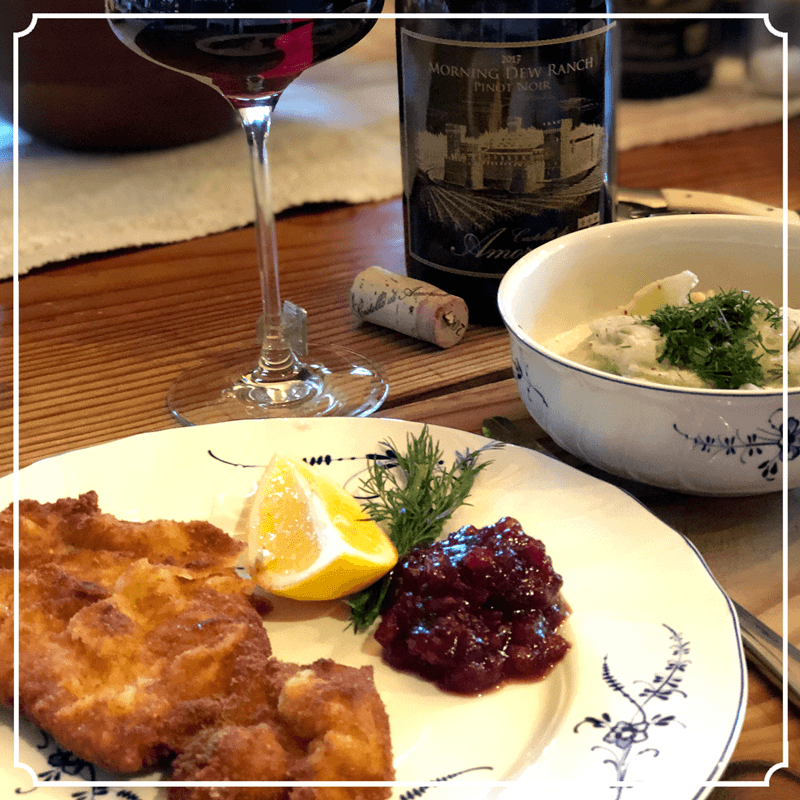
Schnitzel Ingredients
- 2 pounds pork loin cut into 1/3″ thick pieces (tenderized to 1/4″ thick)
- 4 eggs
- 1/4 cup heavy cream or milk
- 3 cups all purpose flour
- 5 cups regular bread crumbs
- 500 mL grapeseed oil
- Salt and pepper
- 1 lemon
- 1 cup lingnonberry or cranberry sauce
Cucumber Salad Ingredients
- 3 cucumbers, peeled and sliced thin
- 1/2 red onion, sliced thin
- Salt to taste
- Pepper to taste
- 1 tsp sugar
- 3 tsp white or apple cider vinegar
- 6 tsp heavy cream
- 3 tsp fresh dill, minced
Autumn Mushroom Medley

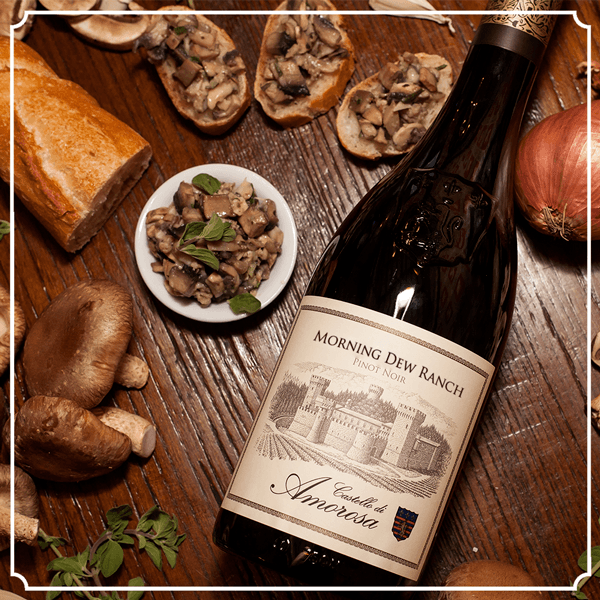
Recipe Date: August 26th, 2018
Difficulty: Easy
Measurements: Imperial (US)
Sautéed Autumn Mushroom Medley
From Mary Davidek
Ingredients
- 10 oz Shitake mushrooms
- 10 oz Portobello mushrooms
- 20 oz Crimini mushrooms
- 16 oz Italian chicken sausage
- 1/2 cup butter
- 1 shallot
- 4 cloves garlic
- 1/2 bulb fresh fennel
- 4 oz dry white wine
- 5 oz chicken or vegetable stock
- 1/4 cup grated Fontina cheese
- 1/4 cup grated Parmesan cheese
Directions
- Sauté diced sausage in a large sauté pan; drain fat and set aside.
- Finely chop shallot, garlic, and fennel and sauté with white wine and 1/4 cup butter. Add to cooked sausage and set aside.
- Finely chop mushrooms and sauté with remaining 1/4 cup butter and 4-6 oz of stock until desired texture (about 12 minutes), adjusting liquid as needed.
- Add vegetable and sausage mixture and let cool slightly before folding in cheeses.
- Serve on crostini and pair with Pinot Noir.
Enjoy!
Related Products
Terra de Promissio - Checkmate Castello

Mary Davidek
Terra de Promissio Pinot Noir – Checkmate Castello
I love a game of chess, deep thought and out-maneuvering, strategy and calculating, all while carefully not giving up your advantage. Chess is also an apt metaphor for many life situations; social posturing, politics of work, positioning friends, and dare I say…family? Business is a place we commonly employ schemes and strategies, even the business of wine can pose circumstances which entail positioning and thoughtful approach. Admittedly this may seem counter-intuitive; to many, wine is perceived to be artistic and cerebral. Wine evokes romance and esoteric conversation, not strategy or offensive and defensive tactical maneuvers. However, as in all business, great success requires planning and navigating. After all, for a winery, in the vast world of palate-pleasing if one only makes wine one likes or prefers, you may appeal to, well, one.
Which brings me to my point…and yes, I have one.
At a recent staff meeting the topic du jour was the release of the Castello’s much anticipated Pinot Noir from the Terra de Promissio vineyard in Sonoma County. Certain die-hard cab-loving staff members were having a bit of a challenge wrapping their mind and palate around this particular bottling. Full disclosure, this is not a Cabernet lover’s Pinot. No, the Terra de Promissio vineyard is planted with prized Burgundy clones, the fruit displays structure with finesse and elegance rather than some Cali Pinot Noir’s cab-like vim and vigor.
This pedigreed vineyard is located on a 50-acre ranch in Sonoma, overlooking the town of Petaluma in an area of much viticultural success known as the Petaluma Gap. Caution; an internet search result may yield directions to an outlet mall so include the term ‘Pinot Noir’ if searching for info about the Petaluma Gap. (unless you are looking for jeans or a sweater!)
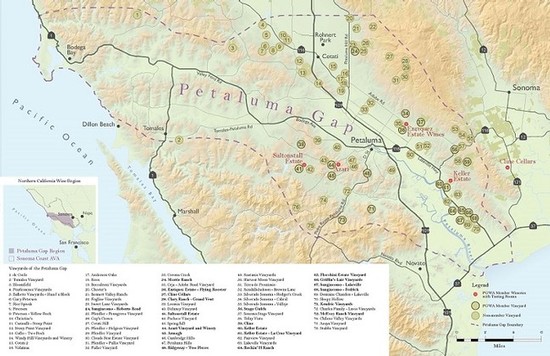
The “Gap” is actually a wind gap named for the coastal mountain opening that stretches east from the Pacific through the town of Petaluma and south to San Pablo Bay. This marine cooled gap creates perfect growing territory for cool temperature loving thin-skinned Pinot Noir grapes.
With the acquisition of Terra de Promissio fruit, Castello has advanced on yet another strategic post of wine making and palate-pleasing, classic old world meets new world Pinot Noir. This base is covered…the palates are pleased. Good move.
Now, back to the point I assured you I would make. While it is true, Cabernet Sauvignon is the powerful king of the sun-drenched Northern end of Napa Valley, Pinot Noir is most certainly the reigning queen from Sonoma.
And, just like the game of chess……it is the queen who takes the game.
Checkmate.
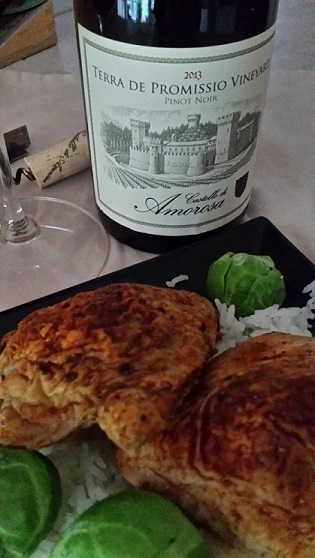
Chinese Five Spice Chicken Thighs
Five Spice is a preblended mixture of Star Anise, Cloves, Cinnamon, pepper and ground Fennel Seed and is a tasty rub for pork, salmon and poultry. Five Spice doesn’t overwhlem Pinot’s subtlely, instead, the bright red fruit notes of the Terra de Promissio Pinot Noir create a perfect complement for this exotic spice rub. This quick and delicious preparation is also ideal for chicken legs or appetizer wings.
Directions:
- Rinse and dry chicken pieces.
- Preheat oven to 375 degrees.
- Coat the chicken with a dry rub of Chinese Five Spice.
- Place the chicken thighs in a pan and into oven and bake for about 25 to 35 minutes – until completely cooked through (an inserted thermometer should read 170 degrees).
- Serve with rice and enjoy!
Pinot Noir— The Art of Getting There

Mary Davidek
Pinot Noir— The Art of Getting There
“There is no ‘there’ there”. Gertrude Stein’s often quoted prose is commonly used to describe something that lacks soul, culture, life, or identity. While Ms. Stein was referring to the faceless existence of city-life, some critics have proclaimed this lament when speaking of grapes grown in and the wine making efforts of America.
The French speak of ‘terroir’ when referring to winemaking and the wines of France which is to say grapes are a reflection of the region in which they are grown; the soil, the climate, the aspect of a hillside, the amount of rain, the surrounding vegetation, etc. The United States’ AVA system has been criticized as nothing more than a weak effort to create a false sense of place in the wines produced — an illusion– as they state, there is nothing ‘there’.
*le sigh*
I decided to look beyond Cabernet Sauvignon, the reigning king of grapes for my initial attempt at disproving this theory and thus directed my attention to a varietal that, in my humble opinion, is ‘place’ personified. Pinot Noir, the thin skinned red wine grape of the Burgundy region of France has become increasingly popular with wine-buying wine-drinking Americans. It is a classic, elegant, food friendly wine—its enigmatic character and appeal as elusive as it is obvious.
Pinot Noir grapes are grown around the world but they flourish in cooler growing regions. In Oregon, the Willamette Valley is nearly the same latitude as the famed Burgundy region of France and has become synonymous with world class Pinot Noir. Oregon producers have found their sense of place as the Pinot fruit embodies the sophistication and finesse of a great Burgundy yet displays layered earth and bright red fruit summoning unrestrained California productions.
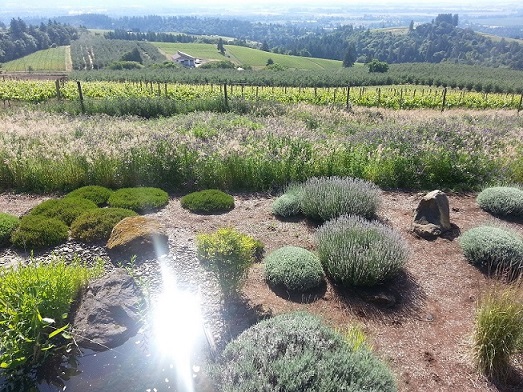
The rolling green hills of temperate Willamette Valley provide the perfect place for cool-climate loving Pinot Noir
California Pinot Noir is more mercurial stylistically without any one style from this large and geographically diverse growing area. From Santa Barbara and the Central Coast to the south and Sonoma County and Anderson Valley in the northern half of the state, diverse topography and weather patterns separate this region of more than 450 miles. From Santa Barbara and the Central Coast we find opulent wines with definitive Pinot Noir fruit that reflects its warmer and more southern roots with a controlled strength. Cooled by the San Pablo Bay, the Carneros region straddles both Napa and Sonoma Valley and shows hints of spice and brightness unique to these cooler vineyard sites of this sun-drenched area. North of Carneros we find the Sonoma Coast where Pinot shows depth and earthy complexity with some of California’s most acclaimed Pinot Noir producers firmly planted in this lush pacific expanse. Further north of Sonoma we find California’s newest Burgundy-like super star in the highly praised and sought after Anderson Valley of Mendocino County. Here the ocean cooled valley floor rarely sees summer temps above 85 degrees….even in the height of the season. Pacific marine influence floods the valley floor with morning coastal fog providing slow even ripening. Enthusiasts agree this temperate region yields fruit of subtle distinction.
A Pinot Noir trio from Castello di Amorosa; Los Carneros, Anderson Valley and the highly acclaimed King Ridge of Sonoma Coast. Each with expressive fruit and character from unique vineyard locations.
As far as American winemaking efforts, maybe we have not come up with anything quite as mysterious as ‘terroir’ to encapsulate the distinctive place of our wines….maybe we never will. But, as the saying goes, sometimes the best part of the journey is getting there.
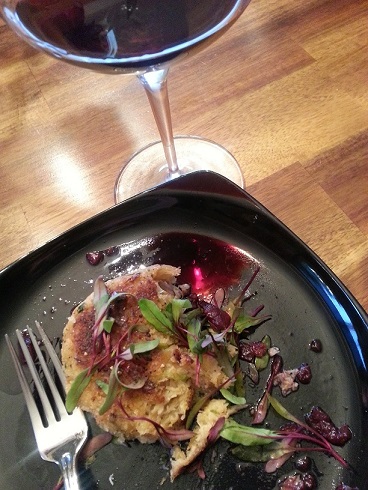
Dungeness Crabcakes with Rainier Cherry Pinot Noir Reduction
For the reduction-
- 10-15 ripe cherries, pitted and chopped
- 10 ounces Pinot Noir
- 1 Tbsp Honey
- 1 Tbsp Seasoned Rice Vinegar
- Pink peppercorn to taste
Add all ingredients to sauce pan. Slowly reduce over medium heat.
Mary Davidek C. S., S.W.
